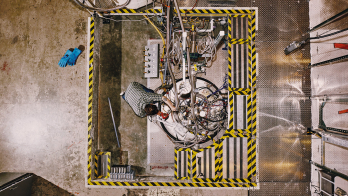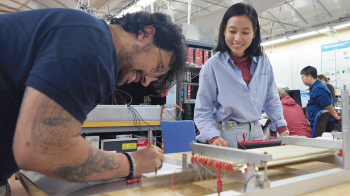At the heart of the ATLAS experiment at the Large Hadron Collider (LHC), silicon sensors will provide accurate detection of charged particles produced in the collisions. The Semiconductor Tracker (SCT) consists of silicon microstrip sensors located 25-55 cm from the LHC beams, subdivided in a central part of four concentric barrels around the beam pipe, and endcaps of nine discs on either side. February saw two major milestones for the ATLAS tracker within a week – the first stage of the integration of the barrels with other parts of the tracking system and the arrival of the endcap silicon tracker that has been assembled in Liverpool.

The ATLAS tracker project was conceived in 1993 at a meeting in the UK where a small international group of physicists and engineers sketched out plans for a tracking system for the LHC. After four years of development, 40 institutes around the world agreed to start the construction of the SCT. Eight years later the tracker is now a reality at CERN and is being integrated into ATLAS ready for physics.

The central barrels and two endcaps of the SCT together hold 4088 silicon modules (60 m2 of silicon), which can record the trajectory of charged particles with 20 μm precision (less than the diameter of a human hair). The complete system comprises 6 million detector elements, each with its own amplifier and memory. It is larger than any existing silicon tracking system. Careful work at each stage of the project has ensured that more than 99.5% of the channels are working.
The modules for the SCT barrels were produced by four collaborations centred in Japan, Scandinavia, the UK and the US, and sent to the UK for precision assembly on cylindrical structures at Oxford University. The fourth and final barrel arrived at CERN in September 2005 and was integrated into the full barrel assembly shortly afterwards. In the latest integration stage, on 17 February, dozens of physicists and engineers from the collaboration gathered to witness the insertion of the barrel SCT into the Transition Radiation Tracker (TRT). The SCT and the TRT are two of the three major parts of the ATLAS inner detector – the third and final part is the pixel detector, which will be added in the very centre of the tracker.
While the SCT central detector is already complete at CERN, the two endcaps are making good progress as well. More than 2000 modules with sensors and readout electronics have been produced in laboratories in the UK, Spain, Germany, the Czech Republic, the Netherlands, Switzerland and Australia, and were then sent to the two endcap assembly sites at the University of Liverpool, and NIKHEF in Amsterdam.
Each endcap is a 2 m long, light and strong carbon-fibre cylinder containing a series of nine discs on which the modules are mounted in rings, so as to surround the LHC beams. Each disc contains cooling circuits to take away the excess heat produced by the electronics, to maintain an operating temperature of -7 °C, which is chosen to minimize radiation damage in the harsh LHC environment. Control signals and data are sent through optical fibres to and from each sensor, minimizing noise and heavy cabling. On 23 February the first endcap arrived safely at CERN from Liverpool and the second is nearing completion at NIKHEF







